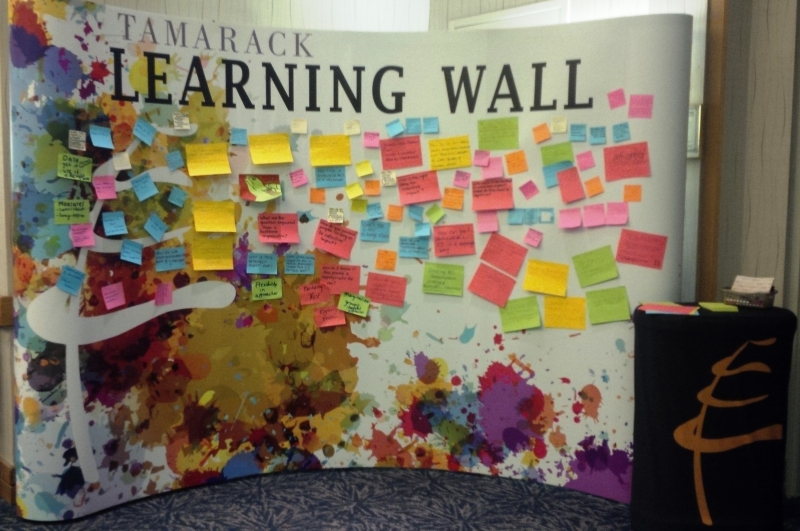We’re now into day 2 of the Collective Impact Summit in Toronto this week, and I am very happy to share highlights from sessions, keynotes, and from attendee learnings from Oct. 7, 2014.
DAY 2 HIGHLIGHTS
Our focus: Essential Mindset Shifts for Collective Impact
KEYNOTE HIGHLIGHTS | JOHN KANIA:
John Kania of FSG presented the morning’s keynote address that focused on the question, “What makes collective impact work?”
The Five Conditions of Collective Impact build a foundation – Mindset Shifts Are Also Needed to Do the Work
Mindset Shift One: Who is Involved?
- Get all the right eyes on the problem – new eyes bring new vision
- Move from what is obvious to what is not obvious.
- This work is not counterintuitive, it is counter-cultural
- What if each of us could see what everyone sees, what if we had collective vision?
- How much we can accomplish in this world depends how much we can see
- If you want to change the system, you have to get the system in the room
Mindset Shift Two: How People Work Together
Getting things to scale requires a different way of working together: Collective Seeing – Collective Learning – Collective Doing:
- This is adaptive work, not technical work. Solutions that emerge are not known in advance
- The people who are impacted by the issue need to be the ones who solve it
- CI offers a structure to organize and make this work
- The dominant paradigm assumes that pre-determined solutions and emerging rules of interaction are needed for large scale change – Collective Impact focuses on pre-determined rules of interaction and emerging solutions
Mindset Shift Three: How Progress Happens
- It is important to discern between Program Strategies and Transformation Strategies
- The four Strategies for Transformation are:
- Increasing Coordination: finding ways to re-align existing programs and stakeholders to maximize system efficacy
- Enhancing Services: bringing in previously unnoticed practice, movement or resources to enhance existing local services
- Policy: advocating for policy change at local or state levels to improve major components of the systems
- Learning through Pilots: start small with willing partners, learn from the experience, and then to expand
- Successful collective impact efforts “bootstrap” successful programs and outcomes are improved through emergence.
Emerging Questions:
- Whose “eyes should be on the problem” but aren’t currently?
- Are your CI strategies program- focused or systems focused?
LEARNING WALL HIGHLIGHTS
 Throughout the Summit, attendees are adding their collective impact questions and thoughts to a growing “learning wall.” Questions posted so far include:
Throughout the Summit, attendees are adding their collective impact questions and thoughts to a growing “learning wall.” Questions posted so far include:
Relationships are the Foundation of Change
- Who’s in the room? Do we have the right eyes on the problem?
- When the cast of people is constantly changing, it’s difficult to gain momentum. What are our rules for engagement?
- People need TIME to talk to each other – often we don’t allocate time for this
- How can we involve “enemies” without comprising our values?
- How do we evaluate levels of trust?
Transformation
- Adaptive work is organic and emergent
- Transformation is counter-intuitive. Going beyond the physical, almost spiritual
- Are we doing it right? Validate. Course correct. What does “right” mean?
Program vs. System Focus
- Shifting to see things differently
- Where do programs fit in system change work?
- Where do we delineate the scope of a system?
Resources
- How do we change the paradigm so that those who hold resources understand the values of being relational/co-creating?
- Change costs money…lack of money becomes the first excuse for not doing something…often when things get started the money will come
AHAs
- Collective Impact is a strategy for collaboration that requires system thinking
- When you hear great ideas they seem so obvious. So why didn’t I think of that?
- Have patience to do a deep dive not knowing the answer. Embrace the unknown.
SOCIAL MEDIA HIGHLIGHTS:
Throughout the event, attendees are sharing thoughts, questions, and photos on social meda. To see what’s being shared, follow #CISummit2014 on Twitter.
Diane Dyson @Diane_Dyson
“We need to trust each other enough to collaborate to solve these complex, messy problems,” @CEO_TorontoFdn #TVS2014 #CISummit2014
PCMH @PCMHontario
Adaptive leadership is creating the conditions for others to make progress. System leaders catalyze collective leadership. #CISummit2014
Jeff Loomis @loomisyyc
‘We are program rich, but system poor’. Focus on how people work together and interact to create system change by J Kania #CISummit2014
Rachel @rachelsmind
2nd #collectiveimpact mindshift: how people wk together matters. When people get along, change happens. Relational trust! #CISummit2014
Mark Holmgren @mjholmgren
Who shares the “change” table is important. Many voices, many minds, many ideas and questions. From #CISummit2014
AllysonHewitt @AllysonHewitt
Love that the #CISummit2014 starts with music and play allowing us to tap into other parts of our brains
REACHedmonton @REACHedmonton
“Remember why we do this work – it’s not for fame.” – Phoebe, CISummit Delegate #CISummit2014
SHARE YOUR SUMMIT EXPERIENCE
If you are participating in the Summit, please share your highlights here on the Forum. We’d love to hear what’s resonating with you throughout the conference.
READ MORE

